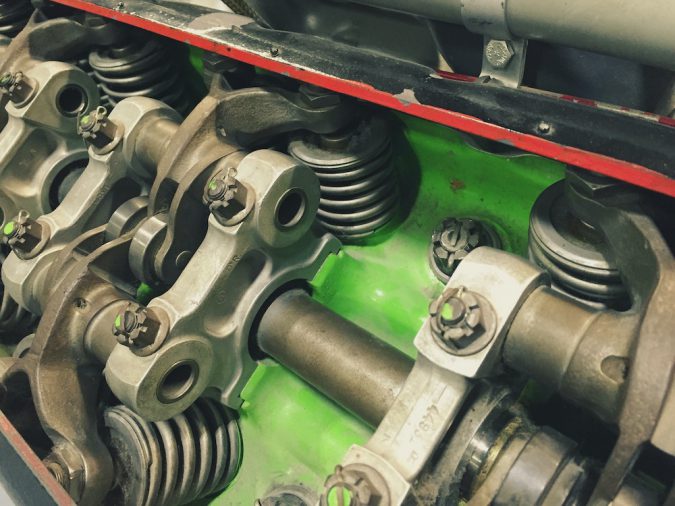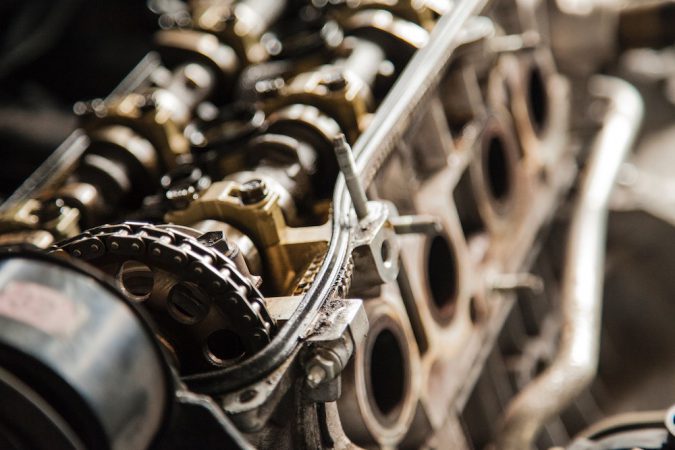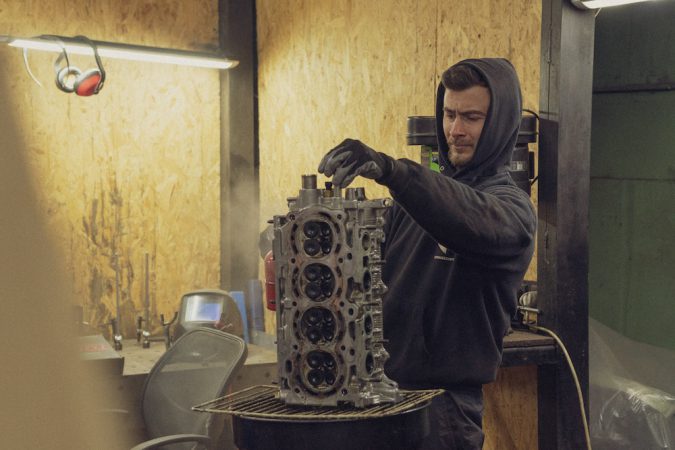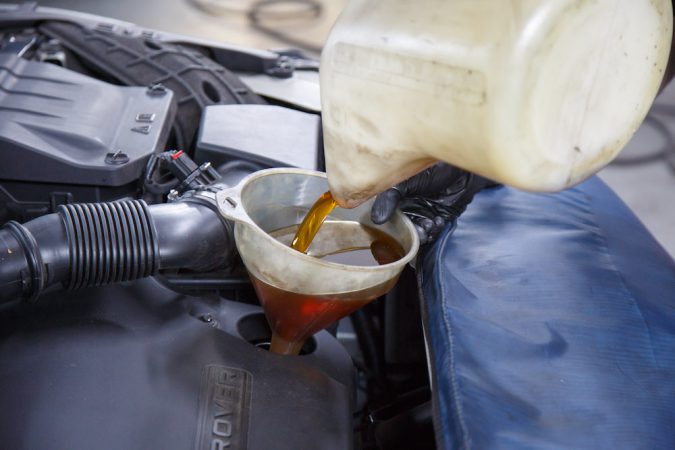One could make the argument that automobile engines haven’t changed much in the last 100 years or so. Sure, today’s engines have evolved to take on an abundance of electronics, computers, sensors, as well as minute refinements to the blueprints hatched over a century ago by our pioneers. Although, a lot of it remains the same, which is why a camshaft replacement cost is no piffling expense.
Camshafts are a key component of every internal combustion engine. Sitting at the very top, its sole job is to control the opening and closing of both the intake and exhaust valves. In other words, those camshafts can be seen as the jaw muscles of an engine. They carefully force the engine to open up, as air and fuel are fed into the engine to be lit on fire and combust, while fumes are then exhausted.
Given their importance, camshafts don’t usually fail, and are more often than not, highly dependable. Nevertheless, be it due to old age and wear and tear in the engine. Or, perhaps even poor servicing on the part of the owner, camshafts are susceptible to breakage. When it does let go, a proper camshaft replacement cost isn’t cheap. By all accounts, it can cost you thousands owing to their complexity.
What Are Camshafts, Anyway?
Before we get into the camshaft replacement cost, just what is a camshaft, in the first place? As we’ve summarised earlier, camshafts are placed right near the top of the engine. It can be seen as a narrow, long tube, with lobed sections to them. These egg-shaped lobes are what’s called the ‘cams’. The cam or lobes on the camshaft are then connected to the intake and exhaust valves of each cylinder.
As your engine runs, the camshaft rotates. With its rotation, the lobed cams will open and close those aforementioned intake and exhaust valves accordingly. It needs to do so and carefully time it with the movement of the pistons. As the pistons are pushed downwards, the camshaft’s lobes will open up the intake valves. This lets air and fuel into the cylinder. The intake valve closes as the piston bottoms out.
The mixture of air and fuel is then compressed and combustion. As one combustion cycle completes, and as soon as the intake valve closes, the exhaust valve opens. The gases that are created as a result of the combustion of the air-fuel mixture will then be exhausted through the exhaust valves. All fumes are to be forced out by the piston’s upward motion. Later, the fumes will exit through your tailpipes.
This process is subsequently repeated thousands of times every minute, corresponding to your engine RPM (revolutions per minute). ‘Camshaft’ shouldn’t be confused with ‘crankshaft’. The latter sits at the bottom of the engine, translating the pistons’ up and down motion into rotational energy. Although, the camshaft and crankshaft need to synchronize their movement in unison with the pistons’ motion.
What Are The Different Types Of Camshafts?
While we’re here, it’s also good to discuss two other key components in the design of camshafts. The first is the rocker arm. The cams on the camshaft push down on the rocker arm, which ultimately pushes down onto the valves to open and close them. Meanwhile, we then have springs that bring the valves back to their closed position. These springs also need to maintain contact with the rocker arms.
So far, we can conclude that camshafts are crucial to not just the smooth operation of an engine, but also its performance. With that in mind, there are several configurations of camshafts in use today. Understanding them will be useful in determining the camshaft replacement cost:
- Single Overhead Camshaft (SOHC) – Here, there’s a single cam for each cylinder. For inline engines, this means one cam for every (cylinder) head. Whereas for V-type engines (like V6 or V8), there’ll be two cams for each cylinder.
- Double Overhead Camshaft (DOHC) – In this scenario, you have two cams for each cylinder (head). An inline engine will have two cams per head, while V-type engines will have four each. DOHC is mainly used in performance-focused engines, with four or more valves on each cylinder.
- Pushrod – This is an old-school design that isn’t commonly found today. Like other engines, the valves are still found on the engine head, right above the cylinder. However, a pushrod camshaft sits inside of the engine block, rather than on top of the head, as it pushes a long rod to operate the valves.
- Variable Valve Timing – Variable valving enables the use of multiple camshafts. For instance, you could have two intake cams, running in sequence to one another. Or, it can enable the cams to operate at different timing and angles, for varying performance.
What About A Camshaft Position Sensor Replacement Cost?
In addition to the actual camshaft replacement cost, you’ll have to worry about its position sensor. So, what is this tiny sensor, anyway? As we’ve noted earlier, modern cars are kitted out with a bountiful amount of electronics. These typically ensure that your car can function as efficiently and as smoothly as it can. Meanwhile, also doles out a decent amount of performance for you to enjoy.
The camshaft is no different, with a sensor dedicated just for it, the camshaft position sensor. Its role is as its name implies. Primarily, a camshaft position sensor monitors the position, rotation, speed, as well as motion of the camshaft. Then, reporting that data back to the car’s central computer, an ECU, or ‘engine control unit‘. Or, a ‘powertrain control module‘, depending on what car you’re driving.
In doing so, your car’s ECU could extrapolate the camshaft’s movement to calibrate the best possible ignition timing. Or in other words, determining the best time to inject fuel into the engine, the proper amount that’s needed, and so on. This is on top of keeping a close eye on engine intake, exhaust, and compression or combustion, all at the same time. It can help improve your engine’s performance.
Plus, the camshaft position sensor can report back if there are any faults with the camshaft. Note, the camshaft position sensor is more susceptible to wear and failure compared to the actual camshaft. It can share similar symptoms to a failed camshaft, so proper diagnosis is recommended. You can read more in our guide on camshaft position sensors, and note the relatively cheaper cost to replace them.
What Are The Symptoms For A Camshaft Replacement Cost?
There could be a variety of reasons as to why you need a camshaft replacement cost. Commonly, this can be narrowed down to it being old and worn out after years or decades of use. It may also fail due to poor engine maintenance, as well as sensor-related faults. The latter is especially problematic. Bad sensors can poorly calibrate the engine’s combustion process, putting extra strain on the camshaft.
Lackluster lubrication, using old or poor valve lifters (they actuate the opening and closing of intake or exhaust valves), or any other mechanical issues could also accelerate damage to the camshaft. Even a simple missed oil change or oil leaks could be detrimental to the camshaft’s lifespan. This includes an aggressive driving style, as is the case with performance cars, that puts pressure on the camshafts.
There is one positive side to this story, however. It’s quite rare for camshafts to fail, as a whole. One of the most common causes for failed camshaft is a design defect or flaw by the manufacturer. But if and when the camshaft(s) in your car does fail, and you need a camshaft replacement cost, do note down these symptoms. Failing to act promptly on a replacement can cause significant engine damage.
1. Check Engine Light
Seeing a check engine light (CEL) on your gauge cluster is never a good sign. Nonetheless, it does help in quickly alerting you that something on your car’s amiss, and isn’t working right. Plus, the CEL can throw error messages or OBD trouble codes, which you can analyze further using an OBD scanner.
This should handily aid you in narrowing down the exact fault that’s prompted the CEL to appear, and hopefully, you can get it fixed soon. Seeing that the camshaft has a camshaft position sensor, this has made it much easier for camshaft-related faults to be tagged by the CEL and alerting you to it.
If you see the CEL, plug in an OBD scanner to see what’s up. If it’s the camshaft (or the position sensor) is the true cause, the following error codes might appear:
1.1. Camshaft-Related OBD Error Codes
- P0010 – Intake Camshaft Position Actuator Circuit/Open (Bank 1)
- P0011 – Intake Camshaft Position Timing – Over-Advanced (Bank 1)
- P0012 – Intake Camshaft Position Timing – Over-Retarded (Bank 1)
- P0013 – Exhaust Camshaft Position Actuator Circuit/Open (Bank 1)
- P0014 – Exhaust Camshaft Position Timing – Over-Advanced (Bank 1)
- P0015 – Exhaust Camshaft Position Timing – Over-Retarded (Bank 1)
- P0016 – Crankshaft Position Camshaft Position Correlation Bank 1 Sensor A
- P0017 – Crankshaft Position Camshaft Position Correlation Bank 1 Sensor B
- P0018 – Crankshaft Position Camshaft Position Correlation Bank 2 Sensor A
- P0019 – Crankshaft Position Camshaft Position Correlation Bank 2 Sensor B
- P0020 – Intake Camshaft Position Actuator Circuit/Open (Bank 2)
- P0021 – Intake Camshaft Position Timing – Over-Advanced (Bank 2)
- P0022 – Intake Camshaft Position Timing – Over-Retarded (Bank 2)
- P0023 – Exhaust Camshaft Position Actuator Circuit/Open (Bank 2)
- P0024 – Exhaust Camshaft Position Timing – Over-Advanced (Bank 2)
- P0025 – Exhaust Camshaft Position Timing – Over-Retarded (Bank 2)
1.2. Camshaft Position Sensor-Related OBD Error Codes
- P0340 – Camshaft Position Sensor Circuit Malfunction
- P0341 – Camshaft Position Sensor Circuit Range/Performance
- P0342 – Camshaft Position Sensor Circuit Low Input
- P0343 – Camshaft Position Sensor Circuit High Input
- P0344 – Camshaft Position Sensor Circuit Intermittent
- P0345 – Camshaft Position Sensor A Circuit (Bank 2)
- P0346 – Camshaft Position Sensor A Circuit Range/Performance (Bank 2)
- P0347 – Camshaft Position Sensor A Circuit Low Input (Bank 2)
- P0348 – Camshaft Position Sensor A Circuit High Input (Bank 2)
- P0349 – Camshaft Position Sensor A Circuit Intermittent (Bank 2)
- P0365 – Camshaft Position Sensor B Circuit (Bank 2)
- P0366 – Camshaft Position Sensor B Circuit Range/Performance (Bank 2)
- P0367 – Camshaft Position Sensor B Circuit Low Input (Bank 2)
- P0368 – Camshaft Position Sensor B Circuit High Input (Bank 2)
- P0369 – Camshaft Position Sensor B Circuit Intermittent (Bank 2)
- P0390 – Camshaft Position Sensor B Circuit (Bank 2)
- P0391 – Camshaft Position Sensor B Circuit Range/Performance (Bank 2)
- P0392 – Camshaft Position Sensor B Circuit Low Input (Bank 2)
- P0393 – Camshaft Position Sensor B Circuit High Input (Bank 2)
- P0394 – Camshaft Position Sensor B Circuit Intermittent (Bank 2)
- P0395 – Camshaft Position Sensor B Circuit High Input (Bank 2)
- P0396 – Camshaft Position Sensor B Circuit Intermittent (Bank 2)
- P1340 – Camshaft Position Sensor B Circuit Malfunction
- P1341 – Camshaft Position Sensor B Range/Performance
2. Engine Or Cylinder Misfires
With a failing camshaft, it will no doubt fail to ensure proper engine operation. To put it simply, it may not be able to open and close the intake and exhaust valves at the right time. With a poorly timed and incorrectly judged camshaft rotation, your engine’s performance will begin to deteriorate.
The most obvious tell-tale sign of this is misfiring. It can affect just one cylinder or a set of cylinders in the engine. Moreover, you’ll notice poor performance and hesitation while accelerating. Your car may not drive smoothly as well, with noticeable jerking, shaking, and shuddering, aggressively or not.
Besides a rough and shaky engine, there might be scenarios where your engine wouldn’t start at all. It would refuse to crank and turn over. Alternatively, the engine would eventually start, but you’ll notice it spinning very quickly (read: high or fluctuating RPMs), before falling again.
3. Poor Fuel Economy
This is partly related to misfiring, in addition to a broken camshaft. As it couldn’t open and close either the intake or exhaust valves at the most ideal time, this will affect fuel economy. Even just leaving the intake valve open for a split second longer can lead to additional fuel being dumped into the engine.
Not only is this excessive fuel usage unnecessary, but it’ll make a dent in your fuel consumption. If this isn’t bad enough, your car might emit more tailpipe emissions, too. It might be down to the misfiring or incomplete combustion, or perhaps due to improper operation of the exhaust valves.
4. Ticking Or Tapping Sounds
It might be fairly tricky to notice these, as they’re often intermittent. However, a bad camshaft would emit some strange sounds. This can be heard as loud ticking or tapping noises. The ticking is especially noteworthy, as it can directly be caused by worn-out cam lobes on the camshaft.
Tapping noises are mostly tied to faults with the valvetrain. Nevertheless, both can be attributed to a bad camshaft. Otherwise, it might at least point you towards problems with other components near or around the camshaft. For instance, the valve lifters, rocker arms, springs, and so on.
5. Failed Timing Chain Or Belt
Remember that ignition timing we mentioned earlier? Well, the camshaft and crankshaft need to be able to operate synchronously with one another. Their rotation must be timed correctly, responding to the movement of the pistons, up and down. This is to ensure smooth and reliable operation.
The timing is maintained by either a timing chain or a timing belt. The use of either a belt or chain will differ depending on your vehicle. But in any case, the timing chain or belt connects both the camshaft and crankshaft together, linking their rotation in unison.
Should either component (camshaft or crankshaft) fail, it’ll naturally put additional strain and wear on the timing belt or chain. With a bad or failing camshaft, the timing chain or belt might fail, as well. It needs to be replaced promptly, as poor timing could easily damage the engine internally.
6. Metallic Flakes In Oil
If the camshaft were to fail or is on the verge of nearly failing, you might be able to see metal flakes and debris in your engine oil. This is quite literally bits of worn cam lobes on the camshaft, chipping off and its chunks falling into the engine oil below. This will circulate across the rest of the engine.
Although, it might be tricky to spot these metal flakes and debris. You can’t easily see them using the dipstick alone. Instead, pay close attention to the contaminants and impurities floating around in the oil during your next oil change. If there are small shiny metal sprinkles, it might be the camshaft.
While you’re getting your car serviced, you could also use this opportunity to inspect the camshafts for any visible damage. Remove the cam cover, and see if the cam lobes are visibly worn out. Or, see if you can find scored journals or other burn marks, as well as scratches on the camshafts.
How Much Is For A Camshaft Replacement Cost?
Finally, we get to discussing a camshaft replacement cost. So, how much is it? While the camshaft is a rare point of failure with most cars, it can be a pain to get it replaced if it does fail. A broad spectrum for a camshaft replacement cost will be anywhere from $700 to $3,000. But this is a fairly wide range, as for most cars, it’ll average between $1,200 to $1,500 for a camshaft replacement cost.
The parts themselves are relatively cheap, as you can get a replacement camshaft for between $300 to $500. In some higher-performance cars or heavy-duty vehicles, the camshaft might cost you closer to around $600 to $800 or more. However, the bulk of the camshaft replacement cost is attributed to the labor charges involved. Replacing the camshaft is a tricky and arduous task for any mechanic.
Even with experienced hands, it can take many hours for disassembly of the engine, taking out the old camshaft, and swapping the new one in. In most vehicles, labor fees alone will account for $1,000 or more. For those vehicles where their camshafts are harder to get at, you might even be looking at the labor rates soaring to $1,500, $2,000, or higher. In all, it’s a terribly expensive job to undertake.
Here’s a TL;DR summary of camshaft replacement cost, for reference:
- Diagnostic – $100+ (this is only applicable if you have the mechanic conduct a thorough diagnosis of what’s wrong)
- Parts – $300 to $500+ ($600 to $800+ for high-performance camshafts)
- Labor – $1,000++ (sometimes upwards of $2,000+ for cars with difficult access to the camshafts)
- Total – $1,200 to $1,500 (average for most cars, with some costing as much as $4,000+ for luxury or performance vehicles, or as little as just $700 for some)
What Are The Factors Affecting The Camshaft Replacement Cost?
So, let’s try and narrow down what a camshaft replacement cost might look like for your car. After all, the final tally can vary significantly depending on several key factors. These include:
- Make And Model – The make and model of your vehicle ultimately tells us the type, configuration, and design of the camshaft you’re using. For instance, some might have a single overhead cam, while others may have a double. Two camshafts will naturally increase the material cost, as well as the work that’s required to replace them both.
- Accessibility – Given how labor costs account for the lion’s share of a camshaft replacement cost, any reduction there would be welcomed. In short, the easier the camshafts are to get to, the lower your labor expense will be. Accessing the camshafts requires at least a partial disassembly near the top of the engine. Meanwhile, boxer-type engines will have camshafts on the sides or flanks of the engine.
- Overhead Or Pushrod – Continuing with our point on accessibility, we then have to look at what is the specific placement of your camshafts. Overhead cams are the cheapest to work on, as they sit at the top of the engine, where it’s easy to access. Meanwhile, pushrods will be extremely costly, as it’s placed deep inside of the engine, where extensive disassembly is needed.
- Additional Replacements – Replacing the camshafts may demand certain other parts connected to the cams to be replaced, too. For example, the camshaft position sensor ($100 to $400+), camshaft seal ($350 to $500+), and valve cover gasket ($200 to $300+) are the most common ones. Perhaps, your timing belt or chain might have to be replaced, depending on their condition.
How To Prevent Needing A Costly Camshaft Replacement Cost?
Having understood now the expense of a camshaft replacement cost, and the catastrophic damage it can cause to your engine, is there a way to prevent it? As we’ve detailed already, camshaft failures are a rare occurrence. The most common point of failure is the camshaft position sensor, not the camshaft itself. The entire sensor can be replaced for around $200 on average, sometimes far less than that.
On the other hand, a simple camshaft might cost you $1,000, or likely higher, skyrocketing to several grand a pop. It’s a good thing then, that complete camshaft failures don’t happen often. They can last hundreds of thousands of miles, without breaking a sweat. Although, there are some things that you could do to slow down the pace of wear and tear on your camshaft.
At the very least, doing these can extend the lifecycle of your camshafts for just that bit longer:
- Keep up with your oil change. Dirty, contaminated, old, burnt-out, or an insufficient amount of engine oil can deprive the camshaft of much-needed lubrication. Thus, accelerating the rate of wear.
- Try to practice a more moderate driving style, with less aggression. Going hard on the engine, usually with high-performance cars, can put unwanted strain on the camshaft.
- Do attend your car’s regular maintenance and service intervals. Several components around the cams, such as the lifters or rocker arms, may need replacing after some time. Continually driving with worn-out examples of those will put additional pressure on the camshaft.
- Always find a qualified and skilled mechanic to work on your camshafts. Especially in regards to timing or camshaft settings, there are very tight tolerances to work with. Otherwise, an incorrect adjustment could lead to the camshaft operating under non-ideal loads, wearing them out prematurely.
Camshaft Replacement Facts:
- The average cost for camshaft replacement is between $1,389 and $1,619.
- Labor costs are estimated between $882 and $1,112 while parts are priced at $507.
- The cost does not include taxes, fees, or related repairs that may be needed.
- Camshafts are crucial to ensure synchronized engine performance.
- Common symptoms of camshaft failure include check engine lights, misfires, and engine damage.
- Continuing to drive with a bad camshaft is not recommended as it can cause further engine damage.
- Camshafts do not typically fail, but proper maintenance is key to extending their lifespan.
- Diagnosing camshaft issues involves various tests, including diagnostic trouble codes and direct inspection of the camshaft.
- Camshaft replacement involves disassembling the engine and requires professional expertise and tooling.
- Upgrading to a performance camshaft requires careful consideration and consultation with a professional.
Final Thoughts On Camshaft Replacement Cost
Well then, that just about sums it up for a camshaft replacement cost. As you can see, replacing your car’s camshaft isn’t cheap, by any means. For those simpler engines out there, you may get lucky and pay less or just around $1,000 for a camshaft replacement cost. If not, you’re stuck with a repair bill that’s at least $2,000 deep. Worse, certain vehicles may cost you upwards of $4,000 or more.
On average, you can expect a price of around $1,200 to $1,500 for most cars out there. This accounts for both the parts and labor cost, with the latter taking up the bulk of it. It’s a good thing then that a camshaft replacement cost isn’t something you’d often have to worry about. But when it does happen, we hope you’re able to pay close attention to servicing for your car to prevent needing it again.











